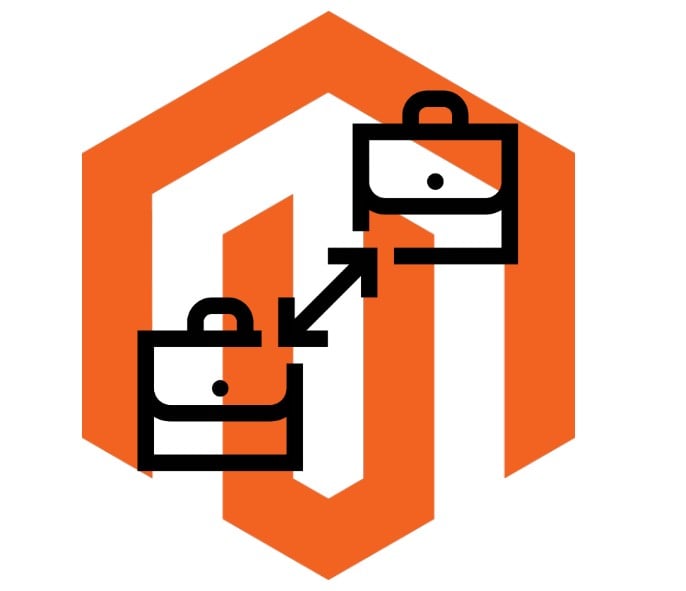Magento 2: The Most Powerful Open-Source Solution For Your E-Commerce Business

No prize for guessing that Magento 2 is currently the most powerful platform that enables you to run an e-commerce website. It is open-source, feature-rich, flexible, and durable. But is Magento 2 as good as numerous articles all over the web chant it? In the following material, we touch upon different aspects of the system to dissipate the myths that surround it.

Table of contents
History of Magento 1
Let’s start our exploration of the platform with a brief history of Magento. Back in 2007, the backbone of what is now one of the most powerful e-commerce solutions has been elaborated. Founded by Roy Rubin and Yoav Kutner, it was developed by Varien with the first beta version released in August 2007.
During the next year, two essential milestones were achieved. In March, the platform was released as Bento. Three months later, Magento Community Edition saw the light of the day. Something that we, along with thousands of other professionals and enthusiasts all over the globe, love and appreciate was born.
The commerce version of Magento became available in 2009. The contradiction between the free and paid platform versions takes place. It was a significant event since it divided the project into the two main branches that continue to impact each other.
Within the next two years, Magento Mobile was launched, and eBay purchased the e-commerce system. While everyone thought that it was “the end of history” for the platform, the relatively calm period lasted just for three years: between 2012 and 2014.
In 2015, Magento 2.0 was officially released. From the technical perspective, it was easier to develop an entirely new platform similar to Magento 1.x than upgrading the existing solution. Thus, we got 2.x with all its benefits and downsides that we describe further in this article. Besides, 2015 was a year when Permira took the Magento Commerce ownership.
When it comes to 2016, it was full of groundbreaking events. Firstly, the notorious Order Management system was released. Secondly, we got the renewed marketplace as well as a new digit after the first dot in the platform’s version – Magento 2.1 was launched. Thirdly, Magento Commerce Cloud became available.
In 2017, numerous platform features that shape its current look came to fruition. B2B, Shipping, Business Intelligence, and others augmented the platform’s existing set of features.
However, a shocking event took place in 2019. Adobe purchased the platform. We focus on this event further in this chapter.
As for the next year, it was relatively calm. Magento 2.3 was released, but the community all over the globe was waiting for 2020. No, nobody knew about the corona pandemic and its impact on e-commerce. Something more predictable should happen – . This platform version is no longer supported, but we’ve just received Magento 2.4 with all its glory.
Magento 2 & Adobe Acquisition

Why do we pay additional attention to the Magento 2 Adobe acquisition? Because there were lots of questions regarding the purchase, some of which still have to be answered.
What happens when a corporation purchases a cool underground (or partly underground and entirely community-backed in the case of Magento) project? It starts monetizing it to the maximum extent so that the poster child of benign underground ideas of freedom turns to something mediocre and over-commercialized. The Magento community was frightened of that (and still is to some extent). Among the most common concerns was a thought that Adobe would shut down Open Source to focus on Commerce only. Luckily, this didn’t happen. So, the first myth is dismantled.
Although Adobe tries to uphold Magento’s standards, the company’s shift towards corporate clients is apparent. Still, everyone can leverage the Open Source version for free, investing a relatively low budget into a feature-rich digital storefront.
You can read more about the concerns caused by the acquisition here: The Magento Adobe Acquisition & Its Impact On The Ecosystem.
Magento Editions

Now, when you are familiar with the key landmarks in the history of Magento, let’s explore the essential products Adobe currently offers: Open Source, Commerce, and Cloud.
Technically, two distinct platforms are under your disposal. Firstly, you can build a powerful and flexible e-commerce storefront with the help of Magento Open Source, which was known as Magento Community Edition. Secondly, Magento Commerce is all yours. In its turn, it is divided into two products: an on-premises version – actually Magento Commerce (Enterprise Edition in the past) and a platform-as-a-service – Magento Commerce Cloud (originally dubbed Enterprise Cloud Edition). Two more platforms that now bite the dust are Magento Professional Edition and Magento Go.
Magento Open Source
Magento Open Source is an open-source e-commerce platform that can be considered a foundation for Commerce. You can leverage an abundant palette of features this edition provides and extend its essential characteristics with the aid of third-party modules and customizations. Since the first public beta version of 2007, Magento Open Source paved the excellent way for excellence we can now leverage. Now, it delivers various tools in the following categories:
- When it comes to marketing and conversion features, you can leverage the following functionalities of Magento 2 Open Source:
- Up-sell, cross-sell, and related products;
- Multiple images, swatches, and other visual aspects of a product page;
- Stock availability display;
- Wish lists;
- Promotional pricing and coupons with export and tracking;
- Multi-tier pricing;
- Numerous shipping options;
- Customizable product categories;
- Recently viewed, similar, and new products;
- A persistent shopping cart (non-purchased items are saved for the customer’s next visit);
- Customizable newsletters;
- Product sharing options.
- The platform’s SEO improvements include:
- SEO-friendly URLs;
- Configurable URL rewrites;
- Google sitemap;
- Metadata for various store pages;
- Various site management capabilities are also an integral part of Magento 2 Open Source:
- A single admin panel for multiple stores;
- Admin roles and permissions for access admin pages and tools;
- Integrated content management system;
- Customizable site templates;
- International business options: multiple currencies, languages, and tax rates;
- CAPTCHA functionality + two-factor authentication;
- Import and export features;
- As for catalog management features, they are:
- Single, configurable, bundled, grouped, downloadable, and virtual products;
- Product attributes and predefined attribute sets;
- Inventory management with automated notifications;
- Out-of-stock notices;
- Automatic image resizing;
- Product reviews and ratings;
- Special pricing, tiered pricing, customer group pricing, and other similar options;
- Product personalization;
- Checkout, payment, and shipping tools of Magento 2 Open Source provide a broad selection of solutions:
- One-page checkout for both guests and registered users;
- Multiple shipping addresses for a single order;
- Multiple payment options and various gateways;
- Money orders, checks, and purchase orders;
- Numerous shipping provides + real-time shipping rates from leading couriers;
- Flat-rate shipping;
- Shipping methods that follow a customer’s destination.
- On-site order tracking.
- Numerous order management enhancements are also a valuable addition to the platform’s experience:
- Support for multiple invoices and split fulfillment;
- The ability to print packing slips, invoices, and shipping labels right in the admin;
- Email notifications for order status changes;
- Create orders and update shopping carts on behalf of customers.
- Customers can also leverage several benefits that Magento 2 Open Source provides:
- A dashboard with all the necessary data about orders, wish lists, and personal information;
- An address book with default billing/shipping addresses;
- Order history;
- Newsletter subscription controls;
- A shareable wish list;
- Submitted product reviews;
- Easy contact with the store.
- Analytics and reporting solutions of Magento 2 Open Source include:
- Built-in support for Google Analytics;
- Wide variety of reports.
And of course, the platform offers numerous improvements aimed at small screens. Magento’s responsive, mobile-friendly design lets you create e-commerce sites optimized for all devices.
It is also worth mentioning that the development of the 2.X versions of Magento Open Source is coordinated publicly on GitHub. Thus, the proposed changes become part of the platform and sometimes impact the Commerce edition. The community takes an active role in the development of the project. For instance, includes the resolution of 226 GitHub issues provided by the community members. The proposed contributions range from minor code clean-ups to significant enhancements in GraphQL and Inventory Management.
Magento Commerce
On the contrary to Open Source, Magento 2 Commerce has a relatively high price tag that makes it targeted towards corporate clients. The platform not only costs a lot but also provides numerous enhancements and unique features that are not available in its free version. For example, advanced content creation and management tools are under your disposal:
- Page Builder – design store pages with the help of an intuitive drag&drop interface;
- Product Recommendations – let the platform create personalized product recommendations for you;
- Customer Segmentation – create customer segments to reach clients more individually;
- Content Staging & Preview – generate different designs for your website and apply them automatically, following a flexible schedule;
- Instant Purchase – simplify the existing buying process for returning shoppers by letting them skip checkout steps;
- Merchandising – manage your products faster and more efficiently with a simple drag-and-drop interface or sorting rules;
- B2B – make your store oriented towards your business partners.
If you need a tool that includes all theыу functionalities out of the box, then this edition may be more preferable. However, it is possible to get identical features on Open Source with the help of third-party extensions and services, some of which provide even better functionality than the one built into Commerce. The impact of the community is still strong here: the same 226 fixes became a part of the 2.4.0 release.
Magento Commerce Cloud
If Magento Commerce is about an on-premise model, you can also leverage a corresponding cloud option. The appropriate edition contains all the features of the previously described platform, along with several notable benefits. Magento Commerce Cloud is a robust PaaS solution that runs on Amazon Web Services. It delivers managed service infrastructure, provides better performance, enhances security, and offers top-notch scalability. Various supplementary technologies of the platform include Fastly, Blackfire, New Relic, etc. Let’s examine the core benefits of Commerce Cloud:
- AWS hosting. Cloud nature is one of the most significant aspects of the edition. With Commerce Cloud, you get an environment to run an e-commerce business smoothly, operating with maximum efficiency. Even the most essential traffic spikes are no longer a problem.
- Git-based workflow. Magento 2 provides the ability to manage your Commerce Cloud environments right from the GitHub repository. Besides, you can use a Bitbucket or GitLab repository to build and deploy an environment. The current conditions enable pushing code changes automatically.
- Performance tools. With an ece-tools package, you can achieve advanced scalability for deployment. A set of scripts and accessories enables you to simplify cron management, docker deploy environment, project verification, etc.
- Fastly integration. Besides, Magento Commerce Cloud streamlines numerous Fastly services to optimize and secure content delivery. A Varnish-based CDN caches your site for a faster page load. Built-in DDoS protection and Web Application Firewall create a shield around your online storefront. Various image optimization techniques enhance the performance of your e-commerce project.
You can find the three products compared side by side here: Open Source vs. Commerce vs. Commerce Cloud.
Open Source Power & Community Engineering

Community contributions are the foundation of the Magento Open Source platform. They usually include source code patches with fixed bugs or new features delivered by individual developers or companies across the globe. GitHub, with its pull request functionality, is involved in this process, since it is the most developer-friendly way to add fixes to the source code of Magento. The fork and pull model is utilized for providing changes to the Magento 2 codebase. As a contributor, you can maintain a copy of the forked codebase, syncing it with the main branch when necessary. Your forked repository can be used to submit a pull request to the base. Consequently, it is possible to merge a set of changes from the fork into the central repository.
The heterogeneity of contributions varies a lot. It includes new components & features, changes to the existing functionalities, bug fixes, tests, documentation, optimizations, etc. Any good suggestion may become a groundbreaking step towards a better realm of Magento.
All contributions submitted by community developers are carefully reviewed. The Community Engineering Team is responsible for that. During the review, team members might require clarifications from contributors. The answer should be provided within 14 days; otherwise, the issue might be closed. Note that such information as the issue status or who is processing the problem is indicated. You can discover other aspects of this process here: & .
The open-source power of Magento 2 plays a vital role in the development of the platform. Numerous contributions complete every release. Developers all over the world work hard to maintain the platform’s flexibility, scalability, and productivity, exceeding the existing boundaries. No other e-commerce project, which is that big, can boast such tight connections with its community.
Ecosystem of Extensions

Third-party modules for Magento 2 are another aspect that is worth your attention. You can find the best extensions that enhance the default functionality of the platform and often add features that are not available out of the box on . The official Magento extension store is the global resource for apps and services developed to expand Magento solutions with powerful new features.
The essential benefit of Magento Marketplace is that it is trustworthy. All the plugins represented there are carefully examined so that no malware or other insecure products get listed. Extensions are not only secure but also highly efficient and useful since they have to follow the best coding standards and practices to appear on the platform.
Besides, it is easy to find anything you need on the platform. Magento Marketplace provides a curated user experience with good old stuff along with the latest innovators. As a platform visitor, you can discover both new and customized functionalities in key business categories.
At the same time, there are a plethora of extension vendors whose products may not be represented in the marketplace. You can look for their offers on the corresponding company websites.
The intense competition within the community of providers results in the top-notch products and relatively low prices. You may argue that a Shopify plugin is, on average, less expensive than a similar solution for Magento 2. However, the latter is usually more sophisticated and powerful. At the same time, it is worth mentioning that Magento modules are often utilized for recreating Commerce features on Open Source. Thus, comparing prices within the ecosystem is a more intelligent way to find the actual cost since different e-commerce platforms offer incomparable conditions.
You can discover numerous reliable Magento 2 modules split by vendors here: Magento 2 Extensions Reviewed. The article contains a list of plugins explored by the Firebear team.
The Ecosystem of Partners & Agencies

When we talk about third-party extensions, it is also necessary to mention numerous agencies and standalone developers ready to participate in the implementation of any custom e-commerce project. You can find some of our partner-agencies here: Firebear Partner Loyalty Program. Various big and small companies are listed in the article. But many more active agencies offer different services and price tiers. Thus, merchants of any size and complexity can find a reliable partner to build an online storefront that suits the needs of their businesses.
Furthermore, some companies already focus on PWA projects – websites developed on top of Magento 2 with absolutely custom frontend functionality. You can read about this phenomenon here: Headless Magento 2 and PWA.
Such community projects as are also significant from the perspective of the ecosystem. ExtDN is a community of both professionals and enthusiasts willing to improve the Magento universe. They aim to deliver new standards to the Marketplace team, extension developers, and merchants to get better products. Magento Extension Developers Network provides a unique view and ideas on how to revamp the existing experience of both merchants and developers.
Also, numerous community-run projects, such as or , provide the ability to maintain Magento 1 after EOL.
Magento 1 End of Life

2018 was a year when the company officially stated that the first version of the platform would not be supported after June 30, 2020. That day got a loud nickname – the End of Life (EOL). Although no stores vanished at the announced date, the ecosystem changed entirely.
For Magento 1 Enterprise Edition, Adobe discontinued supporting software in , including both quality fixes and security patches. The same situation is analogous to Magento 1 Community Edition and early Magento 2 versions. Although the latest Magento 2 editions are the only official way to run an online store on the platform, several community initiatives represent an alternative approach. However, it is associated with different concerns described here: .
As you can see, Magento 2 is a reliable e-commerce platform with lots of support from community members as well as the robust ecosystem of all possible extensions, tools, and partners. What other benefits are hidden behind it?
B2B: Bright Start & Unstoppable Growth

The built-in B2B functionality of Magento 2 Commerce is what makes the platform truly unique. No other e-commerce solutions offer anything similar. As for Magento, it provides a set of highly intuitive self-service tools that dramatically simplify various routine B2B processes. It is possible to add several buyers per a single company account with a unique set of roles and permissions. Enhanced payment capabilities include the ability to accept payments on account. Another B2B enhancement is associated with custom catalogs and pricing for companies. Quote requests, quick ordering, fast restocking, and reliable support are also under your disposal. The core B2B features of Magento 2 include:
Custom pricing & shared catalogs. Assign custom prices to specific companies. Create numerous pricelists and provide them to different buyers. Define the default public pricing on the frontend for guest users.
Credit Limit. Allow companies to finish checkout with postponed payments and credit limits based on the purchase and payments history. Provide customers with an additional payment method – “Payment on account.”
Company Structure. Create company accounts and assign numerous customers to each company account. Generate specific roles and role-based permission to particular views and actions.
Negotiation quotes. Magento 2 delivers a quotation engine as a part of its B2B suite. It enables buyers to convert their carts to quotes. Thus, negotiations on prices let you leverage two-way communication built into both admin and customer accounts of Magento 2.
Requisition lists. Let your clients combine frequently purchased items into lists and use them for order placement. Requisition lists are not purged when a customer sends items to the shopping cart, so they are fully reusable.
Quick order. B2B clients can use SKUs of the desired items to order them without the necessity to browse the entire catalog.
The essential drawback of the B2B features is that they are available in Magento 2 Commerce only. What are the other negative aspects hidden behind the platform?
Magento 2 Disadvantages

Although the power of the platform is vast, it has some notable disadvantages. Depending on the platform’s edition, these drawbacks differ a lot. Let’s take a look at Magento 2 cons to consider before starting a Magento 2 project.
Price. The first and foremost barrier that doesn’t let merchants use Magento 2 is the price. And it is not a myth. If we talk about Magento Commerce, it is costly. However, there is always a possibility to streamline a slightly limited set of features represented in Open Source. Thus, you can avoid the price issues associated with the platform. As for module-related costs, they may also be considered overpriced, but we talk about one-time payments. You purchase an extension and get it for life. No monthly fees occur.
Overbearing Functionality. The myth is that Magento 2 offers a perfect set of features that suits everyone. You need to choose the correct edition. Let’s be honest: not every corporate client requires the entire collection of features that Magento Commerce provides or the flexibility of Commerce Cloud. Thus, merchants are forced to pay for functionalities they don’t need. How to solve this issue? It is only possible to utilize the Open Source edition and install the necessary tools via third-party plugins. The abundant ecosystem of apps and extensions lets you implement any custom ideas, getting a project that seamlessly fits your business demands.
Complicated Development. Unfortunately, it is not a myth. You need more time and effort to create an average e-commerce storefront on Magento 2 than on other e-commerce platforms. Be ready to commit true development expertise and spend additional money polishing your new storefront.
Limited Migration. Transferring an existing e-commerce website to Magento 2 is a painful process, even if you migrate from Magento 1. It is another painful plane of the Magento universe. The platform is quite limited when it comes to import and export processes. However, the ecosystem of extensions offers numerous solutions that address this issue. For instance, the Improved Import & Export, along with its migration add-ons, lets you transfer data from any external system.
Resource-heavy Platform. Magento 2 requires lots of resources to operate successfully. However, the broad e-commerce possibilities fully compensate for the resource-hungry nature of the platform.
Final Words
Now, when you are familiar with the core cons of the platform, let’s summarize its positive aspects that make Magento 2 the most powerful open source e-commerce solution.
Latest Software Solutions. First of all, you have to deal with a modern technology stack. No reliable solution can be based on outdated software solutions. The evolution of tools depends on the technologies used in their foreground. The bundle of the software behind Magento 2 lets you not only achieve the highest possible performance, but also simplifies the life of developers and, consequently, reduces the price of your e-commerce project. PHP, Zend, Composer, HTML5, CSS3, latest coding standards, and a bunch of other modern instruments form one of the most underestimated advantages of the platform.
Flexibility. The use of the latest technologies, along with the open-source nature of the platform, opens vast possibilities towards customizations. Implement the craziest ideas, creating a storefront that you need – not the one that an e-commerce platform can provide.
Scalability. No other platform is as scalable as Magento 2. The latter quickly grows with your business, effortlessly addressing all challenges related to the needs of your digital storefront. Don’t stand in awe of enterprise-level traffic – Magento 2 will definitely handle it.
Performance. The default Magento 2 installation is rapidly fast. Furthermore, you can increase its performance by using various third-party services and extensions. At the same time, it is possible to exceed the industry norms with the help of PWA that enhances the impact of the built-in full-page caching and Varnish solutions.
Admin-friendly Backend. There is no need to visit courses and spend hours over endless manuals. The Magento 2 backend is exceptionally user-friendly and intuitive. Non-technical administrators will love it from the very first session.
Fast Catalog Setup. Creating categories and products is no longer a problem. Magento 2 lets you set up your catalog faster and easier than ever before. Furthermore, you can leverage import processes to transfer already existing products. Thus, the catalog setup is reduced to just a few clicks.
Mobile-first Experience. More people use mobile devices as a point of purchase. Even B2B customers do that. Therefore, Magento 2 provides its users with a mobile-centric approach. The platform’s themes are optimized for all screen sizes. Furthermore, Magento 2 also offers a mobile-friendly backend, so that your administrators can complete urgent tasks on-the-go.
Third-party Extensions and Tools. Magento 2 has the largest ecosystem of third-party modules in the entire e-commerce universe. The Magento Marketplace lists thousands of them, and more tools are available beyond the official store. You can dig any feature that the platform lacks. Integration with all existing payment gateways, carriers, CRMs, ERPs, personalization engines, and dozens of other solutions is possible.
Top-notch Security. Despite many reported security vulnerabilities, Magento 2 offers one of the most reliable e-commerce solutions. Starting from Magento 2.4, two-factor authentication is mandatory for all admin users. At the same time, the platform regularly releases security patches that fix the existing breaches.
Search Engine-friendly. Magento 2 is optimized for better SEO results. It contains numerous tools, index management or HTML/XML sitemap. If you are looking for more advanced SEO performance, the ecosystem of third-party extensions contains numerous modules that are worth your attention. Getting found online has never been easier.







